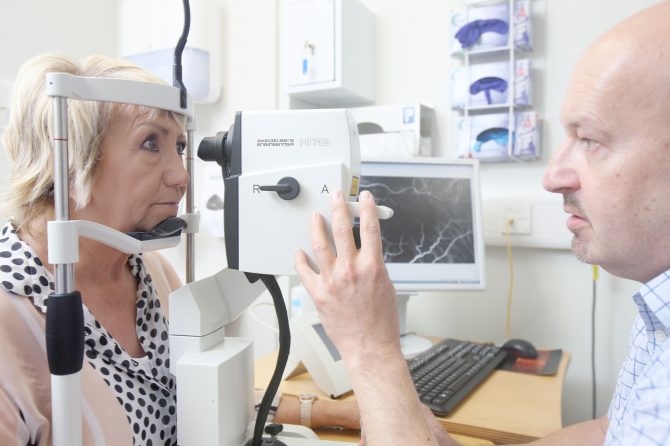A new state-of-the-art centre, which offers the very latest in imaging technology, is playing a leading role in eye health in Bradford.
The Bradford Macula Centre, part of Bradford Teaching Hospitals NHS Foundation Trust, is based on Trinity Road, Bradford, near to St. Luke’s Hospital, and features the most sophisticated scanning equipment capable of detecting a number of eye conditions.
The new centre means that patients with suspected wet macula degeneration (a condition that causes the loss of central vision, usually in both eyes) will be seen and treated quicker, improving the success of the treatment. They can be referred directly to the Bradford Macula Centre by their opticians via a fast-track referral system.
The Trust’s macula service was previously based in the pain management clinic in the grounds of St Luke’s.
Consultant Ophthalmic Surgeon, Faruque Ghanchi, said: “The new centre will both speed up the patient’s journey through the clinic and increase the number of patients we can treat. Ultimately we hope to be able to see twice as many patients as we see at the moment.”
“We will be able to increase the number of clinics from five per week, run over two-and-a-half days at present, to 10 clinics over five days.”
Consultant Ophthalmic Surgeon Helen Devonport said: “The project has been a joint working agreement with Bayer Pharmaceuticals, who have funded a new Optical Coherence Tomography scanner for the unit.”
Highly-detailed images
“Optical Coherence Tomography – or OCT as it is more commonly known – is a scanning system that produces highly-detailed images of the retina. It is often likened to an MRI or x-ray of the eye.”
“OCT Scanning is the most sophisticated tool available for assessing eye health and detecting eye conditions including macula degeneration, diabetic eye disease and other eye disorders.”
“This scanner allows us to see detailed images of the retina (the lining of the back of the eye), enabling us to accurately detect, monitor and manage changes to the retina. This latest technology allows us to see flow in blood vessels in the retina without having to inject patients with dye.”
“Previously abnormal blood vessels could only be detected on photos taken after patients received an intravenous injection of one or two dyes. So we are very grateful to Bayer for their support.”
The Trust’s ophthalmology department is home to numerous worldwide clinical trials which are taking the lead in eye care research. Staff have liaised with local optometrists about the opening of the new centre.
Patient Levi Hall, of Wibsey, Bradford is one of many now enjoying the new and improved facilities.
Mr Hall, 78, who has macula degeneration, has been using the Trust’s macula service for the past 10 years and has seen a number of changes during this time.
Spacious and comfortable
“When I was first referred, I had to attend a clinic at Bradford Royal Infirmary and then it moved to the Pain Management building at St Luke’s, but this new centre is by far the best. The facilities are wonderful. It is so spacious and comfortable and has made a real difference to appointments which can take up to two hours. Everything runs like clockwork.”
“I attend every six weeks now and over the years have taken part in clinical trials, testing different drugs. I have to say, the staff are brilliant, so kind and caring, and now having the new surroundings makes attending clinic so much easier.”
Bayer is a Life Science company with a history stretching back more than 150 years. It is dedicated to working collaboratively with the NHS to develop bespoke solutions to improve retinal services and the provision of care for patients.
Bayer Medical Director for Ophthalmology, Dr Jackie Napier, said: “We are proud to support NHS trusts across the UK to improve care for people with sight-threatening eye conditions.”
“We need to continue to work together as an ophthalmology community to overcome challenges in service delivery so we can preserve patients’ sight as much as possible.”


